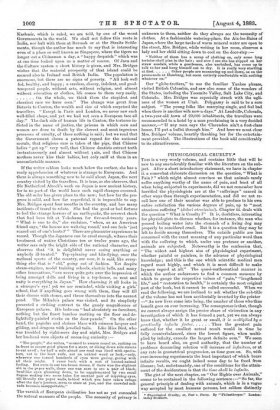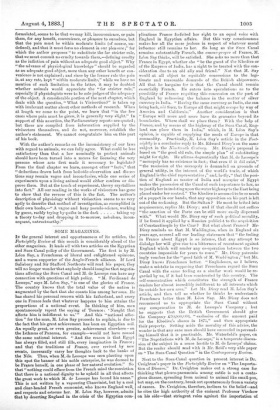PHYSIOLOGICAL CRUELTY.* Tuts is a very wordy volume, and contains
little that will be new to any one tolerably familiar with the literature on the sub- ject. After a short introductory statement, we have iu chapter ii. a somewhat elaborate discussion on the question, " What is Pain ? " which might almost convince us that animals rarely suffer anything worthy of the name of pain, and least of all when being subjected to experiments, did we not remember how horrified the physiologists are at the "sufferings" caused. in other ways than through experimentation, and did we not re- call how one of their number was able to produce to his own entire satisfaction the various degrees of pain, up to "most atrocious suffering " (dolori atrocissimi). Chapter iii. deals with the question " What is Cruelty P" It is, doubtless, interesting for physiologists to discuss whether, for instance, the man who poured boiling water into the stomach of a living dog may properly be considered creel. But it is a question they may be left to decide among themselves. The outside public are less concerned with the exact meaning of any particular word than with the suffering to which, under one pretence or another, animals are subjected. Noteworthy is the confession that, "The widest and highest aim of physiological experiment, whether painful or painless, is the advance of physiological knowledge ; and this is the one which scientific medical men regard most highly, and which it is most difficult to make laymen regard at all." The quasi-mathematical manner in which the author endeavours to find a common measure by which to gauge the respective values of "pain," "lengthened life," and " restoration to health," is certainly the most original part of the book, but it cannot be called successful. When we read the following, we are inclined to ask whether the sub-title of the volume has not been accidentally inverted by the printer —" As new lives come into being, the number of those who thus benefit goes on ever increasing. The consequence is that, though we cannot always assign the precise share of vivisection in any investigation of which it has formed a part, yet we can always know that, whether it be great or small, it is multiplied by a practically infinite factor Thus the greatest pain suffered for the smallest actual result would in time be fully counterbalanced, since the lowest figure, when multi- plied by infinity, exceeds the largest definite sum." We seem to have heard also, on good authority, that the number of problems demanding solution will increase ad infinitum, or at any rate in geometrical progression, as time goes on. So, with ever-increasing experiments the least important of•which bears infinite results, we ought indeed some day to be freed from disease ; but, unfortunately, one of the conditions for the attain- ment of the desideratum is that the time shall be infinite.
The gist of the next chapter, on "Oar Rights over Animals," seems to be contained in the following sentence :—" So far, the general principle of dealing with animals, which is in a vague way accepted by most humane persons, but seldom distinctly
• Ptyriotogioal Cruelty; or, Pact v. Fancy. By "Philanthropos." London: Wiley Brothers.
formulated, seems to be that we may kill, inconvenience, or pain them, for any benefit, convenience, or pleasure to ourselves, but that the pain must be within moderate limits (of course, un- defined), and that it must form no element in our pleasure ;" for which the author proposes "to substitute the far stricter rule, that we must commit no cruelty towards them,—defining cruelty as the infliction of pain without an adequate good object." Why "the advance of physiological knowledge" should be regarded as an adequate good object, more than any other benefit or con- venience is not explained ; and since by the former rule the pain is, at any rate, kept " within moderate limits," while we have no mention of such limitation in the latter, it may be doubted whether animals would appreciate the "far stricter rule," especially if physiologists were to be sole judges of the adequacy of the object. A considerable portion of the next chapter, which deals with the question, " What is Vivisection?" is taken up with irrelevant matter about other methods of research. When at length we come to the point, we learn that "in the few cases where pain must be given, it is generally very slight." In support of this assertion, the Parliamentary reports are quoted ; but these are compiled from information supplied by the vivisectors themselves, and do not, moreover, establish the author's statement. We cannot congratulate him on this part of his book.
With the author's remarks on the inconsistency of our laws with regard to animals, we can fully agree. What could be less satisfactory than that a law nominally to protect animals should have been turned into a means for licensing the very persons whose acts first made it necessary to legislate ? From the final chapter we learn, amongst other "facts," that "deductions drawn both from bed-side observation and dissec- tions may remain vague and inconclusive, while one series of experiments upon a living animal would either confirm or dis- prove them. But at the touch of experiment, theory crystallises into fact." All our reading in the works of vivisectors has gone to show that the reverse of this is the fact. The author's description of physiology without vivisection seems to us very aptly to describe that method of investigation, as exemplified in their own books,—" A vague and hazy pseudo-science, working by guess, rashly trying by-paths in the dark taking up a theory to-day and dropping it to-morrow, nebulous, incon- sequent, untrustworthy."



































 Previous page
Previous page